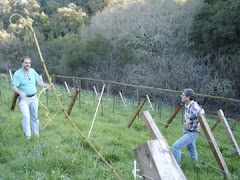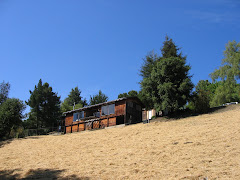February 10, 2008
First a little background information. The native grapes of North America, generally known as "Foxy Grapes", don't make particularly good wines. And the grapes grown in Europe, Vitis vinifera, which make really good wines, didn't & don't do very well when they tried to grow them here, recorded as early as the 16th century by the French in their new colony, Florida. Even Jefferson had difficulty growing grapes at his beloved Monticello. He planted more than 24 European grape varieties, and considered wine was "necessary of life". But as noted in his Garden Book, constant replanting of the vines indicated that they didn't grow well and there is no record of wine ever being produced. Further, he noted that growing grapes for wine was "like gambling". By the way, during 1801, his first year as President, Jefferson spent $2,262 on imported wine, more than he did on food. Presidents of the time were required to furnish food and drink for the President House staff and guests out of their own salaries. During his eight years in office he spent $10,955 on imported wine; in 2008 currency that would amount to more than $175,000.
It turns out that the Grape Phylloxera, or Daktulosphaira vitifoliae, a native North American aphid, killed off the European grapevines when they were grown here. Our little aphid would eventually spread to Europe by 1870's, almost destroying the French wine industry. Too make a long story short, our North American native grapes, are resistant to Phylloxera. Eventually, someone figured out that the European grapevines, Vitis vinifera, could be grafted onto these "Foxy Grapes" roots, which made it possible to grow European grapes here. Too bad the French didn't listen to Spanish, who were grafting Spanish grapevines onto Mexican native rootstock as early as 1524.
Armed with my list of recommended rootstocks, I did a Google search for grape rootstock and found Duarte Nursery, located near Modesto, CA, which happens to be "the place" to go for wine grapes rootstocks. I wanted to find one of my recommended rootstocks grafted with the "La Cuesta" Cabernet "clone", which gives rise to the question, what is a "clone" and how do you "graft" it? But I will save that for next time!
Regards from down in the vineyard (and it really is looking like a vineyard now!),
John Sphar





























































































































No comments:
Post a Comment